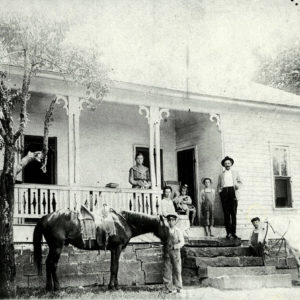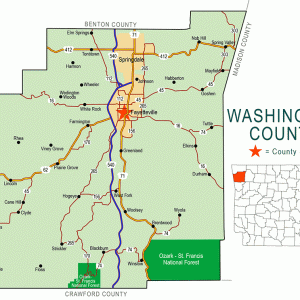calsfoundation@cals.org
Goshen (Washington County)
| Latitude and Longitude: | 36º06’04″N 093º59’29″W |
| Elevation: | 1,191 feet |
| Area: | 11.31 square miles (2020 Census) |
| Population: | 2,102 (2020 Census) |
| Incorporation Date: | October 11, 1982 |
Historical Population as per the U.S. Census:
|
1810 |
1820 |
1830 |
1840 |
1850 |
1860 |
1870 |
1880 |
1890 |
1900 |
|
– |
– |
– |
– |
– |
– |
– |
– |
– |
– |
|
1910 |
1920 |
1930 |
1940 |
1950 |
1960 |
1970 |
1980 |
1990 |
2000 |
|
– |
– |
– |
– |
– |
– |
– |
– |
589 |
752 |
|
2010 |
2020 |
|
|
|
|
|
|
|
|
|
1,071 |
2,102 |
|
|
|
|
|
|
|
|
The city of Goshen is a residential community in Washington County, ten miles east of Fayetteville (Washington County) on Highway 45. Although the community was named and settled early in the nineteenth century, Goshen did not incorporate as a city until 1982.
Eastern Washington County was known for farmland, timber, and game when white settlers first came in the nineteenth century. James Caldwell and John Neill both owned land near the site of Goshen before the Civil War. Some sources claim that Goshen was settled in the late 1820s, but Caldwell’s land grant was not approved until 1843 and Neill’s in 1854. According to some sources, a road named Oxford Bend may have extended from Fayetteville to the settlement as early as 1836. At the time, Goshen itself was not a community, but rather a Methodist camp ground, one of six in the area. Four of the six had biblical names, including Bethlehem, Salem, and Macedonia, as well as Goshen. In the Bible, the region of Goshen was given to Jacob and his family while one of his sons, Joseph, was ruling in Egypt. The Israelites were later enslaved by the Egyptians. African-American slaves in Arkansas and other southern states often used the name Goshen as a metaphor for their captivity, but it appears that the Methodists of Washington County named their campground without being aware of this significance.
The Civil War had a major impact on life in Washington County. Fayetteville was the scene of several military actions and changed hands more than once during the war. Many local farmers served in either the Federal army or the Confederate army, while others served in guerrilla bands not formally aligned with either army. Crops were stolen, and property was destroyed during the course of the fighting. Following the turmoil of the war, more settlers arrived in the area, including Tom McCawley, who came to Arkansas from Indiana. McCawley farmed and also ran a freight wagon between Pierce City, Missouri, and Van Buren (Crawford County). A post office was established at Goshen. Called College Grove when it opened in 1874, the name was changed to Goshen in 1876. By the 1880s, the community had two stores, a flour and meal mill, and a small schoolhouse that also served as a church. William T. Blake opened a blacksmith shop in the late 1880s. Three doctors lived in Goshen around this time.
Crops raised in the area included cotton, grain, and tobacco, but Washington County was most noted for its fruit industry, particularly apples. A large still south of Goshen, near the Madison County line, produced whiskey that was sold in Bentonville (Benton County). By the time of the Depression, fruit production was declining in Washington County, as diseases ravaged the apple crop and as prices fell. Area residents served in the armed forces during both world wars. Pearl Blake, who was one of the first graduates of the nursing program established at the Fayetteville City Hospital, served in the U.S. Army during World War I. After the war, she became the Washington County health nurse.
As the fruit industries declined, poultry and trucking became the principal industries of Washington County. Because of school consolidation, Goshen children attended classes in the Fayetteville school system, where they experienced relatively uneventful desegregation between 1954 and 1957.
Although Goshen had remained unincorporated for more than a century, citizens voted in 1982 to incorporate as a second-class city. The new city government offered services such as water treatment and road maintenance to its citizens. The city remains almost entirely residential, its main landmarks being the Methodist church and the Goshen cemetery. Artist and architect George Dombek maintains his home and studio in Goshen. Civil War soldier Charles Ludwig “Old Scout” Von Berg retired to Goshen; in 2012, his story was included in the documentary Up Among the Hills: The Story of Fayetteville.
Feathers, Tom. “An Old-Timer’s Reminiscences of the Old Days at Goshen.” Flashback 2 (April 1952): 9–10.
Ferguson, Mayme. “Land of Goshen.” Rural Arkansas (July 1990): 8–9, 12.
History of Washington County. Springdale, AR: Shiloh Museum, 1989.
Warren, Lloyd O. “More Ladies of Goshen.” Flashback 39 (August 1989): 22–24.
Steven Teske
Butler Center for Arkansas Studies
 Swift House
Swift House  Washington County Map
Washington County Map 




The Methodist pioneer preacher Rev. William Henry Sherrod (1788-1882) lived and had a farm in Goshen. He moved to Arkansas in 1836 from Tennessee where he was given land for his service in the War of 1812 and, there, he married Charlotte Miller in 1816.
The Oxford family arrived in the area in the late 1820s-early 1830s. According to the Rural Arkansas magazine of July 1990: “As early as 1836 a road known as the Oxford Bend road ran northeastward from Fayetteville. The Oxfords had settled just west of the White River and this road may have extended across the river to the new settlement.” Jacob Oxford was my great-great-grandfather and one of the early settlers in the area.